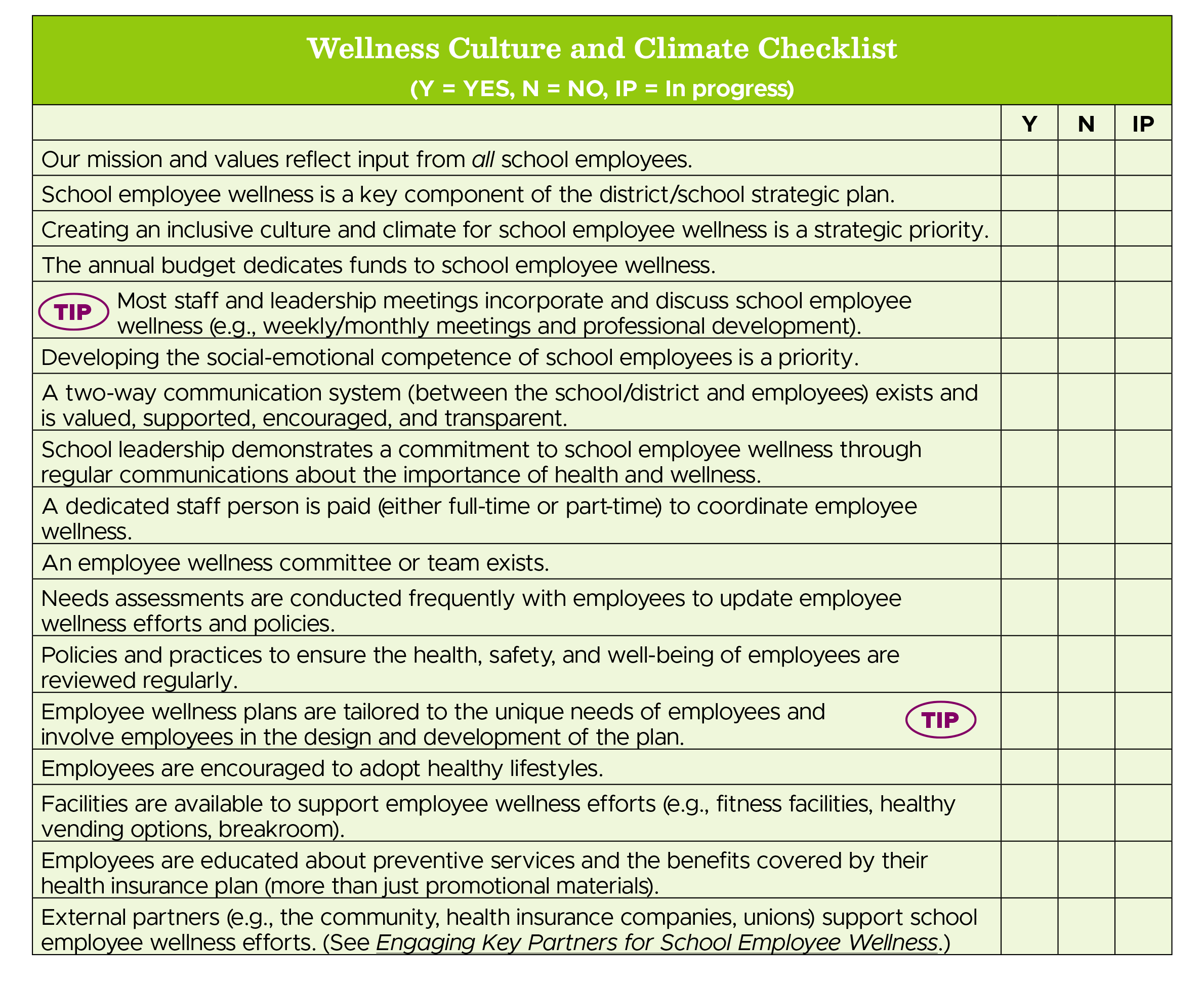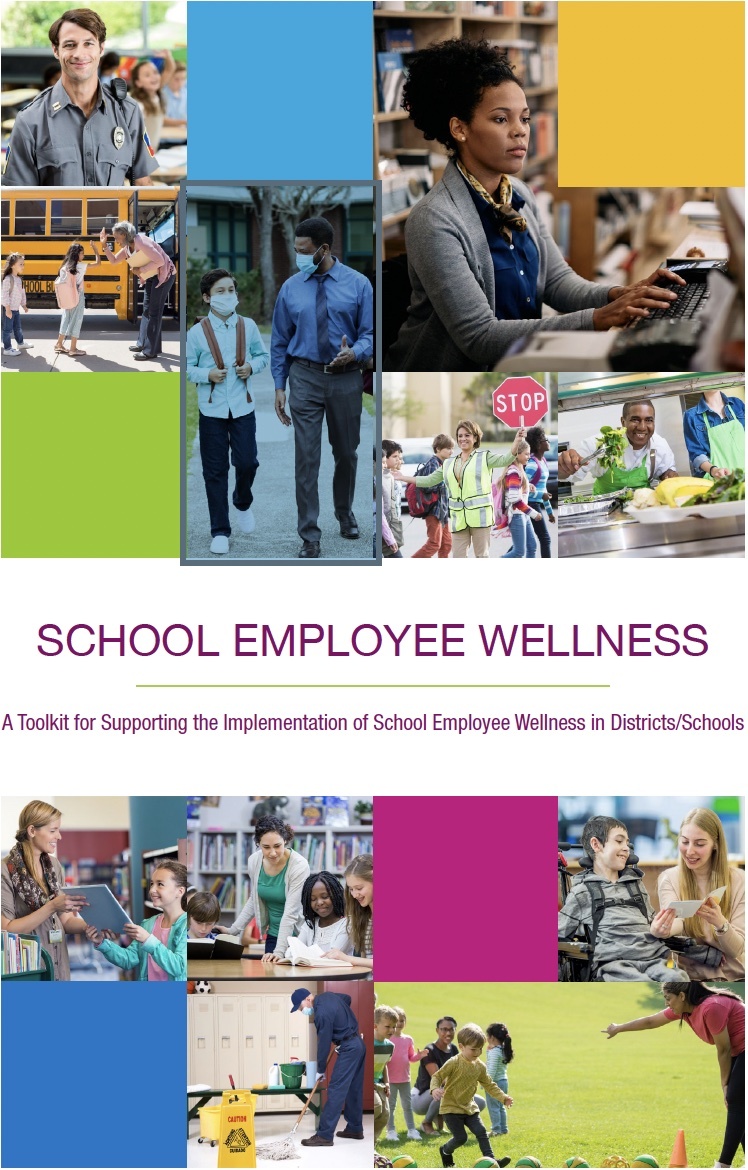
Creating a Culture and Climate of Wellness for School Employees

This resource defines characteristics of a wellness culture and climate and discusses why they are both important. It also provides a checklist to assess your school’s or district’s progress toward creating a culture and climate of wellness, a discussion of the research and importance of addressing emotional well-being for school employees, and a list of resources for developing an employee wellness policy.
An organization’s culture represents the collective values, beliefs, and principles of its employees, and it influences how employees interact and approach work. A variety of factors may influence culture, including history, organizational purpose, type of employees, leadership style, national culture, etc. Culture includes an organization’s vision, values, norms, systems, assumptions, environment, location, beliefs, and habits.1
An organization’s climate is recurring patterns of employee behavior, attitudes, and feelings that characterize work life in an organization. Climate is created by employees’ shared perceptions of the psychological impact of their work environment on their own personal well-being.2
To download fact sheet, please click Creating a Culture and Climate of Wellness for School Employees.
The Importance of Culture and Climate in School Employee Wellness
A culture of wellness can be defined as a workplace that places value on and is conducive to employee health and well-being.3 While a healthy company culture includes encouraging the use of facilities and programs to support health, a culture of wellness extends beyond individual programs by incorporating the value of employee wellness into the overall mission and purpose of an organization.4 Research shows that the integration of employee wellness into an organization’s culture is one of the five key elements of a comprehensive wellness program.5 Establishing a workplace culture that values and prioritizes employee wellness and resilience is important to the overall success of school employee wellness and, ultimately, students’ education.
Organizational values impact the work climate, well-being of its employees, and in cases of schools, also affect the well-being and success of students. Wellness should be an integral part of the way a school operates, thinks, and acts. This integration requires sustained effort on several fronts. It involves leaders:
- Practicing healthy behaviors.
- Implementing health-promoting policies.
- Allocating sufficient resources for programs to be sustained.
- Providing support to ensure safe and healthy environments.
- Offering access and opportunities for employees to engage in a variety of wellness efforts.
- Encouraging all employees to participate in sustainable wellness efforts.
Effective employee wellness programs are embedded in an organization’s culture, benefit design, compensation practices, disability policies, and physical spaces. See the Wellness Culture and Climate Checklist for more ways to create a culture and climate of wellness.

School Employee Wellness Policies
The CDC describes a wellness policy as “a written document that guides a local educational agency’s or school district’s efforts to create supportive school nutrition and physical activity environments.”6 A key to developing a culture and climate of wellness is ensuring the unique needs of each school employee are met within the district/school wellness policies. Many schools have policies on students’ wellness; however, very few address school employee wellness. Implementing a school employee wellness policy is sustainable and builds employee wellness into the fabric of the organization. It shows that employee wellness is valued!
Resources for developing a school employee wellness policy include:
- The Alliance for a Healthier Generation Model School Wellness Policy, accessed by creating an account here.
- Whole School, Whole Community, Whole Child Framework.
- Putting Local School Wellness Policies into Action: Stories from School Districts and Schools.
- CDC’s Virtual Healthy Schools.
- Healthy School, Healthy Staff, Healthy Students: A Guide to Improving School Employee Wellness.
- Wellness Culture and Climate Checklist.
- Taking Action to Improve School Employee Wellness.
Rhode Island State Policy for School Employee Wellness
The State of Rhode Island has a policy requiring school districts to have staff wellness programs that include substance abuse prevention, health assessments, and physical activity opportunities. The state board further requires a school committee to be responsible for the care, control, and management of student and employee health and wellness. The state also includes teacher chronic absenteeism as an indicator of school success in its plan. Learn more about Rhode Island’s State Policy for School Employee Wellness here.
The Missing Link—Adult Social-Emotional Competence and Employee Wellness
School employees are charged with educating our youth, positively supporting their development, and keeping them safe. Supporting school employees—helping them manage their overall wellness, including social and emotional competence—is critical to ensure they are healthy and able to fulfill the demands of their jobs. (See Taking Action to Improve School Employee Wellness: Social-Emotional Health and Stress for adult social-emotional activity ideas.)
Providing all school employees with professional development that focuses on building their own social-emotional skills positively affects the wellness culture and climate of schools. This is in addition to professional development that teaches adults how to build skills in children. Promoting student well-being starts with adults. Adults need skills so they can positively model prosocial behaviors, label emotions, and demonstrate empathy, positive relationships, social awareness, and self-awareness for students. When schools cultivate the social and emotional competence and capacity of the adults in the building, employees feel supported and empowered, can collaborate effectively, and build relational trust.
Studies have found that adults who can recognize, understand, label, express, and regulate their own emotions
- Are less likely to report burnout.8
- Have higher levels of relational trust with their peers at work, which lays a foundation for productive collaboration.9
- Improve their own well-being and the social, emotional, and academic development of students.10
- Demonstrate higher levels of patience and empathy, encourage healthy communication, and create safe learning environments.11
- Effectively teach and model social-emotional competence for their students.12
- Build and maintain stronger relationships with their students, which leads to improved classroom management and fewer disciplinary problems.13
- Positively contribute to the school’s overall climate.14
- Report greater principal support, higher job satisfaction, and a sense of personal accomplishment.15

References
UCLA Center to Eliminate Health Disparities and Samuels & Associates, Failing Fitness: Physical Activity and Physical Education in Schools (Los Angeles, CA: The California Endowment, January 2007).
“Workplace Health Model,” Workplace Health Promotion, Centers for Disease Control and Prevention, May 13, 2016, https://www.cdc.gov/workplacehealthpromotion/model/index.html
“What Is Health Equity?,” Health Equity, Centers for Disease Control and Prevention, July 1, 2022, https://www.cdc.gov/healthequi...
| Access Date | Quiz Result | Score | Actions |
|---|

